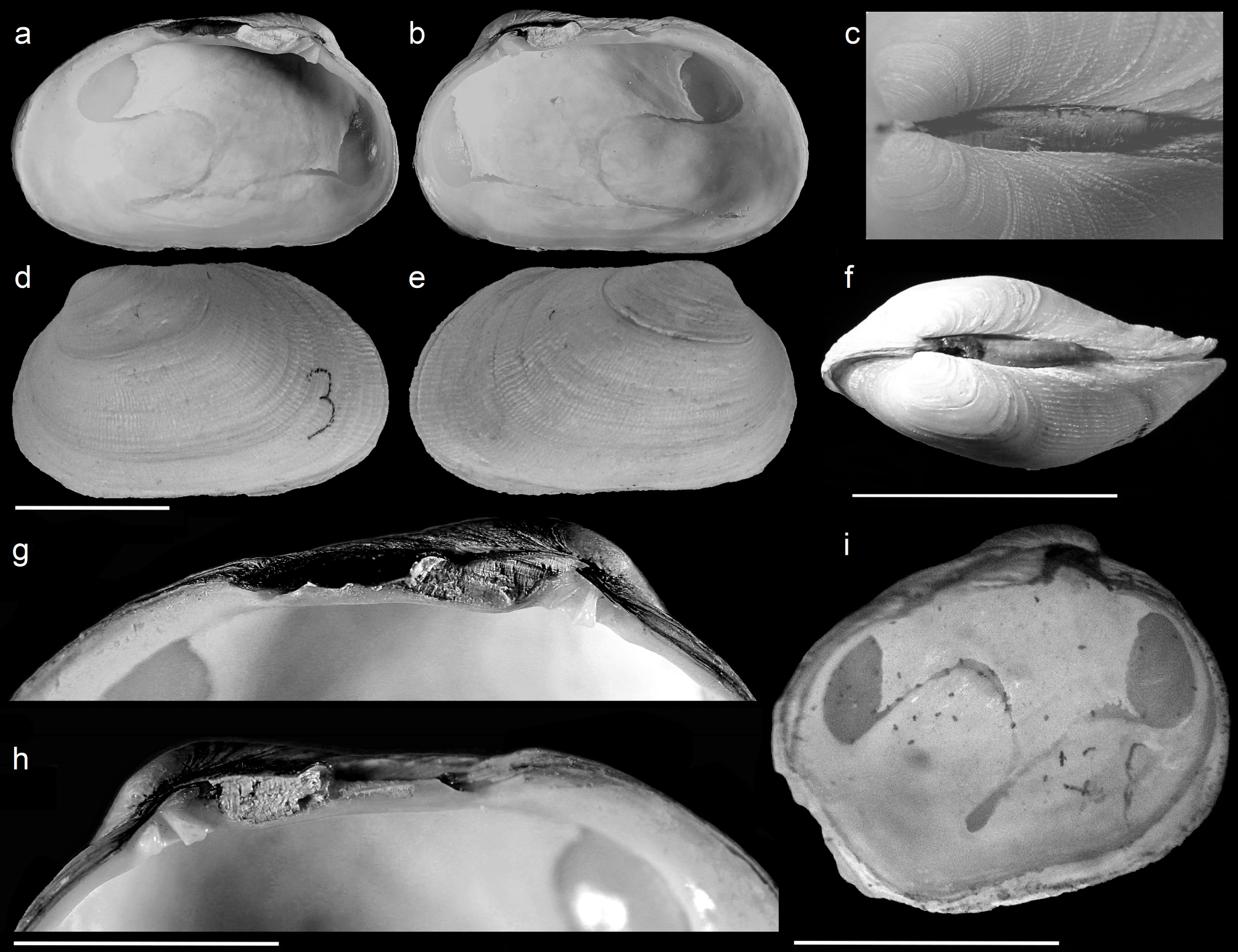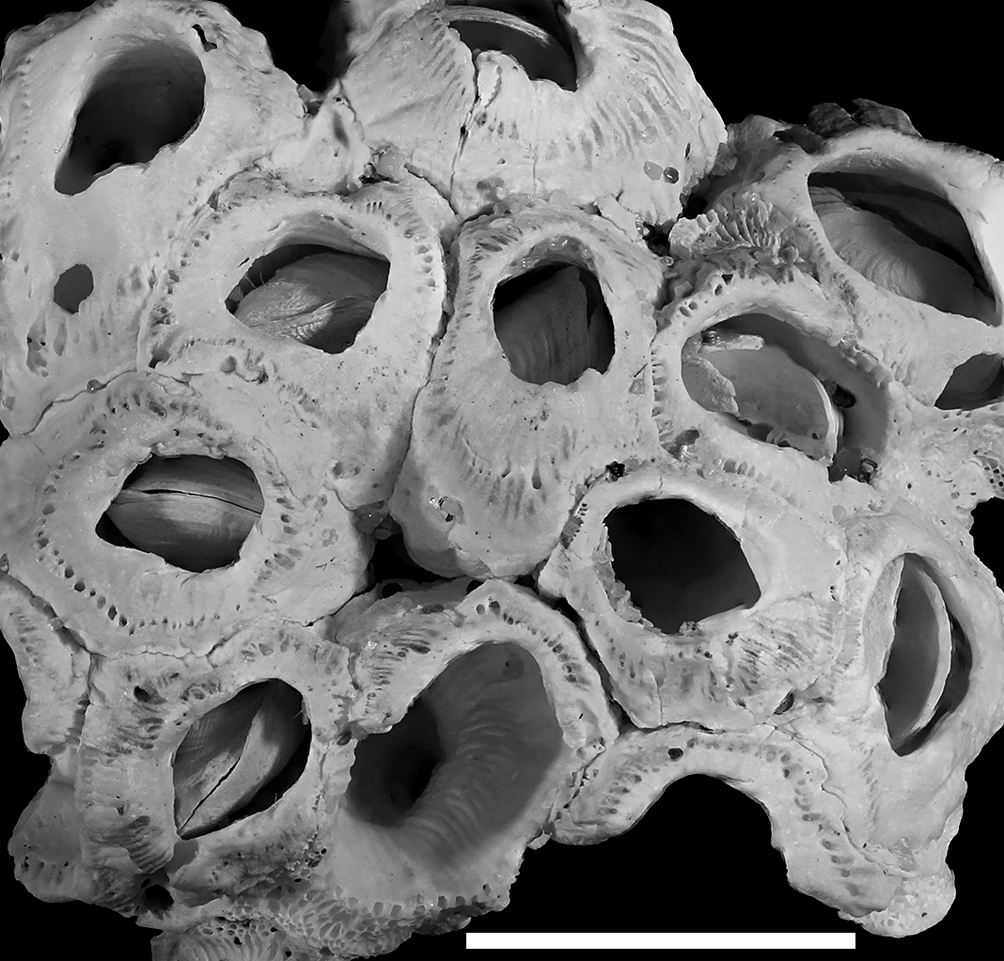A new Petricola (Bivalvia: Veneridae) from central Chile, southeastern Pacific
Juan Francisco Araya a, b *, Cecilia Osorio c
a Centro de Investigaciones Costeras de la Universidad de Atacama (CIC-UDA), Universidad de Atacama, Copayapu 485, Copiapó, Chile
b Programa de Doctorado en Sistemática y Biodiversidad, Universidad de Concepción, Barrio Universitario s/n, Concepción, Chile
c Laboratorio de Invertebrados Acuáticos, Departamento de Ciencias Ecológicas, Facultad de Ciencias, Universidad de Chile, Las Palmeras 3425, Ñuñoa, Santiago, Chile
*Corresponding author: juan.araya@uda.cl (J.F. Araya)
Abstract
A new subtidal bivalve species, Petricola ramirezi sp. n., is described from specimens collected from among cirripedian communities at Playa El Tabo (33º27’ S, 71º38’ W), central Chile. With a maximum recorded length of 16.3 mm, Petricola ramirezi is one of the smallest species in the genus found in the southeastern Pacific, and it is the fifth species from the subfamily Petricolinae recorded in Chile.
Keywords:
Bivalvia; Boring mollusks; Petricolinae; Shallow water; New species
© 2019 Universidad Nacional Autónoma de México, Instituto de Biología. Este es un artículo Open Access bajo la licencia CC BY-NC-ND
Una nueva Petricola (Bivalvia: Veneridae) de Chile central, Pacífico sureste
Resumen
Se describe un nuevo bivalvo submareal, Petricola ramirezi sp. n., de ejemplares recolectados entre comunidades de cirripedios en la playa El Tabo (33º27’ S, 71º38’ O), Chile central. Con una longitud maxima de 16.3 mm, Petricola ramirezi es una de las especies más pequeñas del género encontrada en el Pacífico sureste y es la quinta especie de la subfamilia Petricolinae registrada en Chile.
© 2019 Universidad Nacional Autónoma de México, Instituto de Biología. This is an open access article under the CC BY-NC-ND license
Palabras clave:
Bivalvia; Moluscos perforadores; Petricolinae; Aguas someras; Especie nueva
Introduction
The genus Petricola Lamarck, 1801, encompasses 25 recent species from all over the world (Huber, 2010). These species live in crevices, or in holes made by themselves by mechanical or chemical means, in rocks, or in hard surfaces such as corals, mollusk shells, and in communities of colonial polychaetes (Guzmán et al., 1998; Marincovich, 1973; Morton & Scott, 1988). Of the 14 Petricola species found in the Pacific Ocean, 4 of them are restricted to the northern Pacific Ocean and 7 reach the coasts of Ecuador and Peru in the southern Pacific, while P. concinna Sowerby I, 1834, has not been documented again since Deshayes (1853). Two species are restricted to Peru and Chile (P. olssoni Bernard, 1983 and P. rugosa Sowerby I, 1834), while P. dactylus is found in both the South Pacific and South Atlantic oceans (Aldea & Valdovinos, 2005; Valdovinos, 1999). In this study, part of ongoing studies documenting the biodiversity of bivalves in the Chilean coasts (Araya & Catalán 2016; Araya & Osorio, 2016), we report the discovery and description of a new Petricola species, based on shell characters and morphometry, from specimens collected from inside dead cirripedian shells in central Chile.
Materials and methods
Ninety empty shells of the new species were extracted from inside communities of Balanus laevis Bruguière, 1789, washed ashore at Playa El Tabo (33º27’ S, 71º38’ W), Provincia de San Antonio, Región de Valparaíso, Chile, during July to September 2008. The morphological descriptions, valve length, valve height, valve width, and length of the posterior lamellar part of the ligament (as the distance from the beak to the end of the ligament groove) were measured with Vernier calipers (± 0.1 mm) or by light microscopy. Position of the umbo was defined as the distance of the umbo from the anterior shell margin relative to the shell length. Abbreviations used in the text include; MNHNCL: Museo Nacional de Historia Natural, Santiago, Chile; MPCCL: Museo Paleontológico de Caldera, Caldera, Chile.
Description
Superfamily Veneroidea Rafinesque, 1815
Family Veneridae Rafinesque, 1815
Subfamily Petricolinae d’Orbigny, 1840
Genus Petricola Lamarck, 1801, type species: Venus lapicida Gmelin, 1791
Petricola ramirezi new species (Fig. 1)
urn:lsid:zoobank.org:act:A4974F2D-CB7A-41AA-AF81-56895E7A177E
Diagnosis: shell small (up to 16.3 mm), moderately stout, oval-ovate, sculptured with fine radial ribs on entire teleoconch. Escutcheon and lunule absent. Umbo situated in anterior first third of valve length. Beaks prosogyrate and slightly enrolled. Nymph wide solid. Fibrous layer of ligament occupying about a fourth of valve length. Pallial sinus deep, broadly rounded.
Description of holotype: shell small (maximum length up to 6.5 mm), white, oval in outline, equivalve. Outer surface sculptured with 100-120 regular and fine radial ribs which cover the entire surface of the teleoconch, this sculpture is crossed by faintly defined commarginal striae and by low lamellar ribs. Valves inequilateral, anterior end shortest, rounded; posterior end larger, slightly truncated, with a regularly rounded or slightly straight ventral margin (Fig. 1A, B, D, E). Umbones prosogyrate, convex and prominent (Fig. 1C). Escutcheon and lunule absent (Fig. 1F). Ligament elongated and deep, located posteriorly to the umbones. Interior of valves white, porcelanous; margins smooth (Fig. 1A, B). Pallial line visible, well impressed, pallial sinus deep, broad, rounded, forming a curve in the middle of the shell pointing posteriorly (Fig. 1I). Anterior adductor muscle scar oval, slightly elongate, impressed. Posterior adductor scar slightly shorter, subcircular or rounded; the posterior margin of both adductor muscle scars is slightly narrowed anteriorly. Hinge plate narrow; teeth relatively large, stout; right valve (Fig. 1G) with a subrectangular and vertical anterior cardinal and a bifid and large posterior cardinal; left valve (Fig. 1H) with a stout, large and bifid anterior cardinal, and a narrow, divergent, and subrectangular posterior cardinal. Soft parts unknown.
Taxonomic summary
Type material: holotype: MNHNCL 100476, paratypes: MNHNCL 100477, MNHNCL 100478. All the material was collected at the type locality by C. Osorio, during July to September 2008.
Type locality: El Tabo (33º27’ S, 71º38’ W), Region of Valparaíso, central Chile.
Distribution and habitat: only known from type locality; the shells were found inside shells of the shallow water cirripedian Balanus laevis (Fig. 2), and inside shells of Concholepas concholepas (Bruguière, 1789) and Trochita trochiformis (Born, 1778).
Etymology: named in honor of the late Jaime Ramírez Böhme (Arica, Chile), for his extensive work on marine Chilean mollusks.
Remarks
Adult and gerontic specimens of this new species are variable in outline and shape depending on nestling site. However, its diagnostic characteristics are constant in smaller or juvenile specimens; the radial sculpture is noticeable in even distorted or slightly eroded specimens. Due to this, a small adult specimen was selected as holotype, being more representative of the species.

Discussion
The shell of Petricola ramirezi n. sp. is of a similar size to those of P. concinna and P. olssoni, and the morphology is closest to Petricola carditoides (Conrad, 1837), a species distributed from Alaska to Baja California (Coan & Valentich-Scott, 2012). However, the former of these 3 species can be differentiated from P. ramirezi n. sp. by the presence of a weaker escutcheon, a less impressed pallial sinus, and the lamellar conmarginal sculpture, as well as the stronger and fewer radial ribs. The new species differs from P. olssoni by having a much smaller shell, with more radial ribs, a more impressed pallial sinus and a bright withish interior of the shell, different from the shell internally mottled with orange-brown in P. olssoni, as reported by Coan (1997). Also, P. ramirezi n. sp. differs from P. carditoides in having less inflated valves, a deeper pallial sinus, and in having white juvenile shells (in contrast to P. carditoides’s juveniles which are mottled with brown color).
On the other hand, Petricola dactylus and P. rugosa differ from the new species by their much larger (up to 50 mm), more elongated (P. dactylus) and more inflated (P. rugosa) shells, sculptured with fewer and stronger radial ribs, often more evident at the anterior and posterior areas (Aldea & Valdovinos, 2005; Guzmán et al. 1998). Among the Eastern Pacific species, the only species like the new species herein described is Petricola botula Olsson, 1961, a species distributed from Mexico to Panama (Coan, 1997). However, P. botula has a more tumid and smaller shell, with a sculpture in which the ribs bifurcate in several places; its shell also has a pallial line not significantly bowed dorsally, in contrast with the pallial line in the new species. A species of similar size and habitat, Petricola linguafelis (Carpenter, 1857), also found in the eastern Pacific, from Baja California to Tumbes, Peru, differs from P. ramirezi n. sp. in its very distinctive beaded sculpture (Coan & Valentich-Scott, 2012).
The specialized habitat in different substrata promotes a high polymorphism of petricolid shells. They live and nest in narrow spaces, occupying empty orifices which limit their growth. Petricola ramirezi n. sp. has been found in empty cirripedian shells, and in shells of Concholepas concholepas (Brugière, 1789) and Trochita trochiformis (Born, 1778). This has also been observed for Petricola denticulata Sowerby I, 1834 and P. linguafelis (Carpenter, 1857), which live in shells and in harder substrata, like limestone. Petricola dactylus (Sowerby I, 1823), P. exarata (Carpenter, 1857), P. rugosa (Sowerby I, 1834), P. californiensis Pilsbry & Lowe, 1932 and P. carditoides (Conrad, 1837) have also been observed living inside polychaetes and in teredinidae tubes (Coan, 1997).

Acknowledgements
To Óscar Galvez (MNHNCL) and Gonzalo Collado, for their help with the photos of the new species, and to the two reviewers for their valuable suggestions and corrections on the manuscript.
References
Aldea, C., & Valdovinos, C. (2005). Moluscos del intermareal rocoso del centro-sur de Chile (36–38 S): taxonomía y clave de identificación. Gayana, 69, 364–396.
Araya, J. F., & Catalán, R. (2016). New record of Cuspidaria patagonica Smith, 1885 (Bivalvia: Cuspidariidae) in northern Chile. Gayana, 80, 191–193.
Araya, J. F., & Osorio, C. (2016). Pinna rapanui n. sp. (Bivalvia: Pinnidae): the largest bivalve species from Easter Island, South Pacific Ocean, Chile. Pacific Science, 70, 83–90.
Coan, E. V. (1997). Recent species of the genus Petricola in the Eastern Pacific (Bivalvia: Veneroidea). Veliger, 40, 298–340.
Coan, E. V., & Valentich-Scott, P. (2012). Family Petricolidae. In E. V. Coan, & P. Valentich-Scott (Eds.), Bivalve seashells of tropical West America. Marine bivalve mollusks from Baja California to northern Peru (pp. 842–857). Santa Barbara, California: Santa Barbara Museum of Natural History.
Deshayes, G. P. (1853). Catalogue of the conchifera or bivalve shells in the Collection of the British Museum. Part 1. Veneridae, Cyprinidae and Glauconomidae. London: British Museum.
Guzmán, N., Saá, S., & Ortlieb, L. (1998). Catálogo descriptivo de los moluscos litorales (Gastropoda y Pelecypoda) de la zona de Antofagasta (23° S) (Chile). Estudios Oceanológicos, 17, 17–86.
Huber, M. (2010). Compendium of bivalves. A full-color guide to 3,300 of the world’s marine bivalves. A status on Bivalvia after 250 years of research. Hackenheim: ConchBooks.
Marincovich, L. (1973). Intertidal mollusks of Iquique, Chile. Los Angeles County Museum of Natural History Science Bulletin, 16, 1–49.
Morton, B., & Scott, P. J. B. (1988). Evidence for chemical boring in Petricola lapicida (Gmelin, 1791) (Bivalvia: Petricolidae). Journal of Molluscan Studies, 54, 231–237.
Valdovinos, C. (1999). Biodiversidad de moluscos chilenos: base de datos taxonómica y distribucional. Gayana, 63, 111–164.



